We ran Asana’s homepage through Evelance with a predictive audience of product managers, UX designers, and analysts in California, Texas, and New York. The group included early and mid-career professionals in SaaS, balanced between analytical and intuitive decision styles. The goal was to measure first impressions and trust at the curious stage, the point where interest begins but commitment has not formed. The analysis explores how credibility, pricing clarity, and emotional fatigue shape perception before a single button is clicked.
Dashboard Images
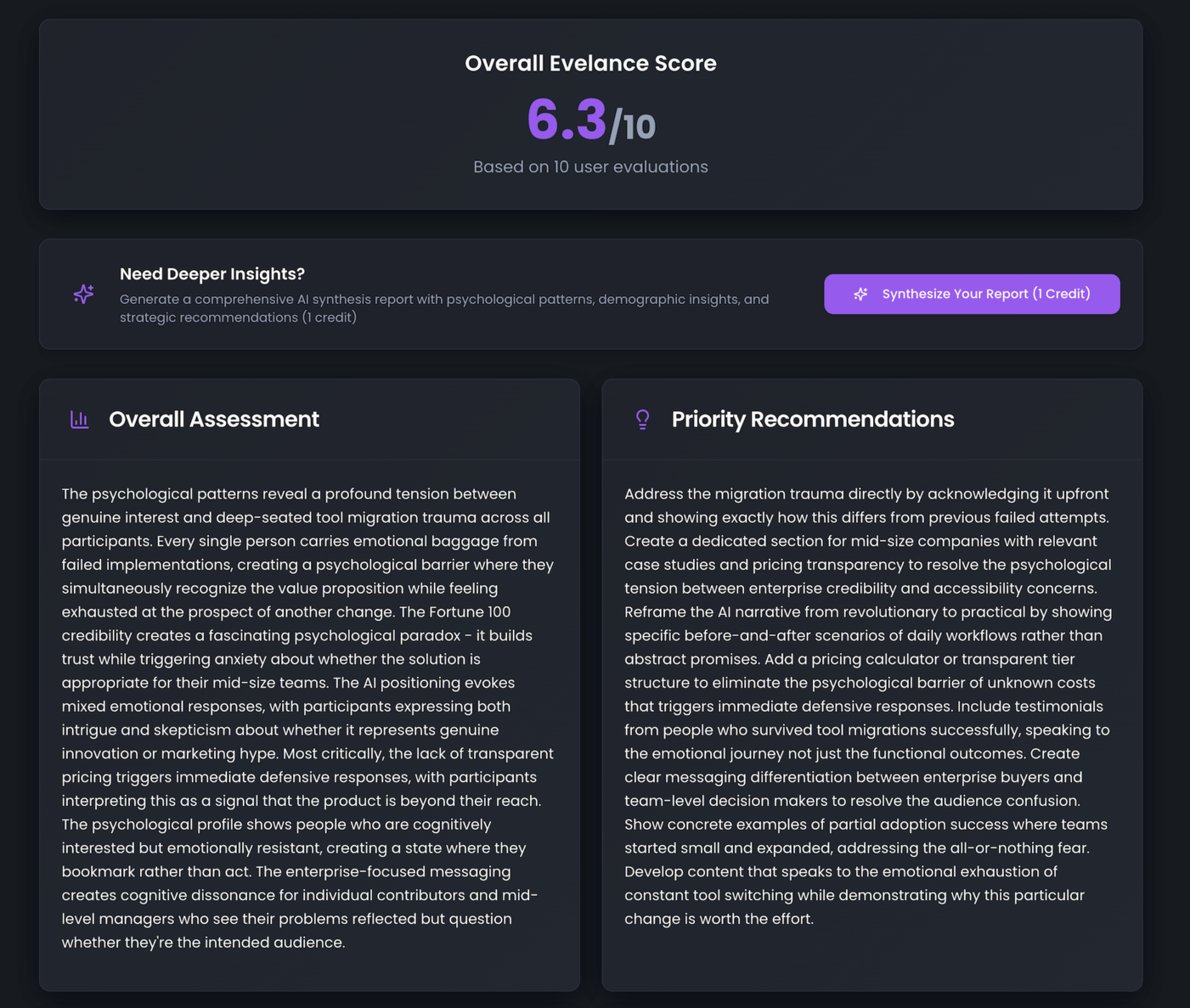
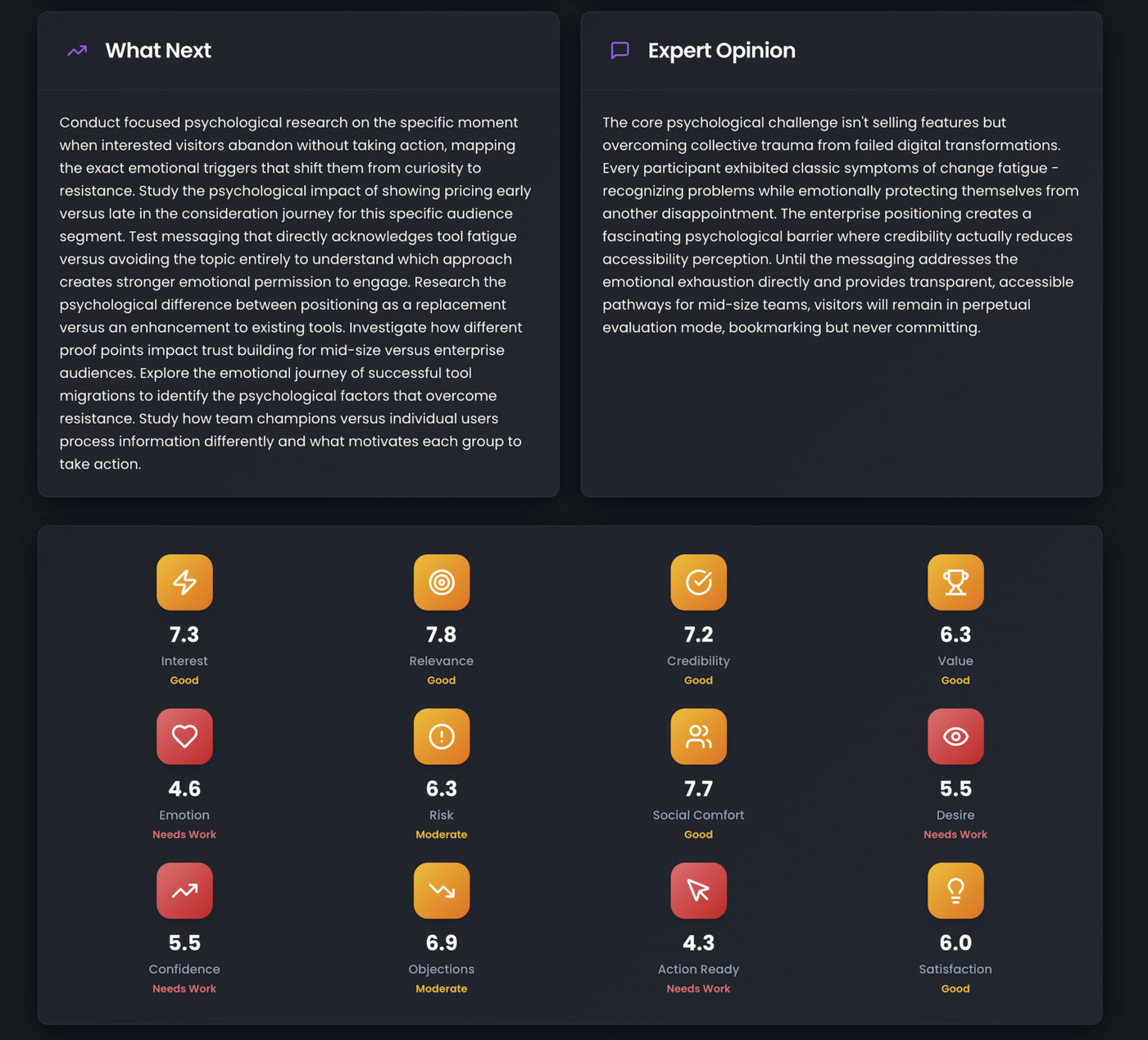
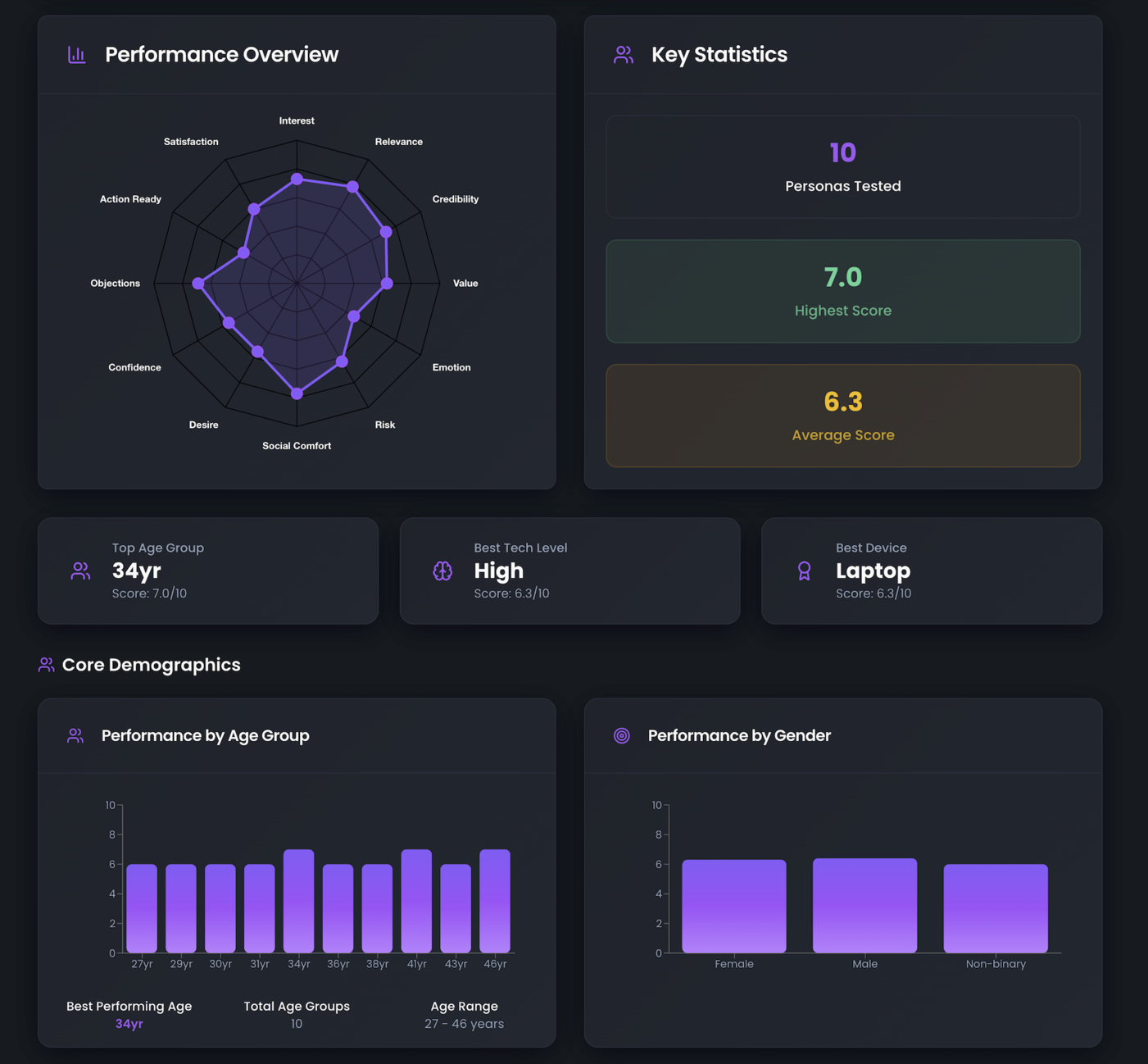
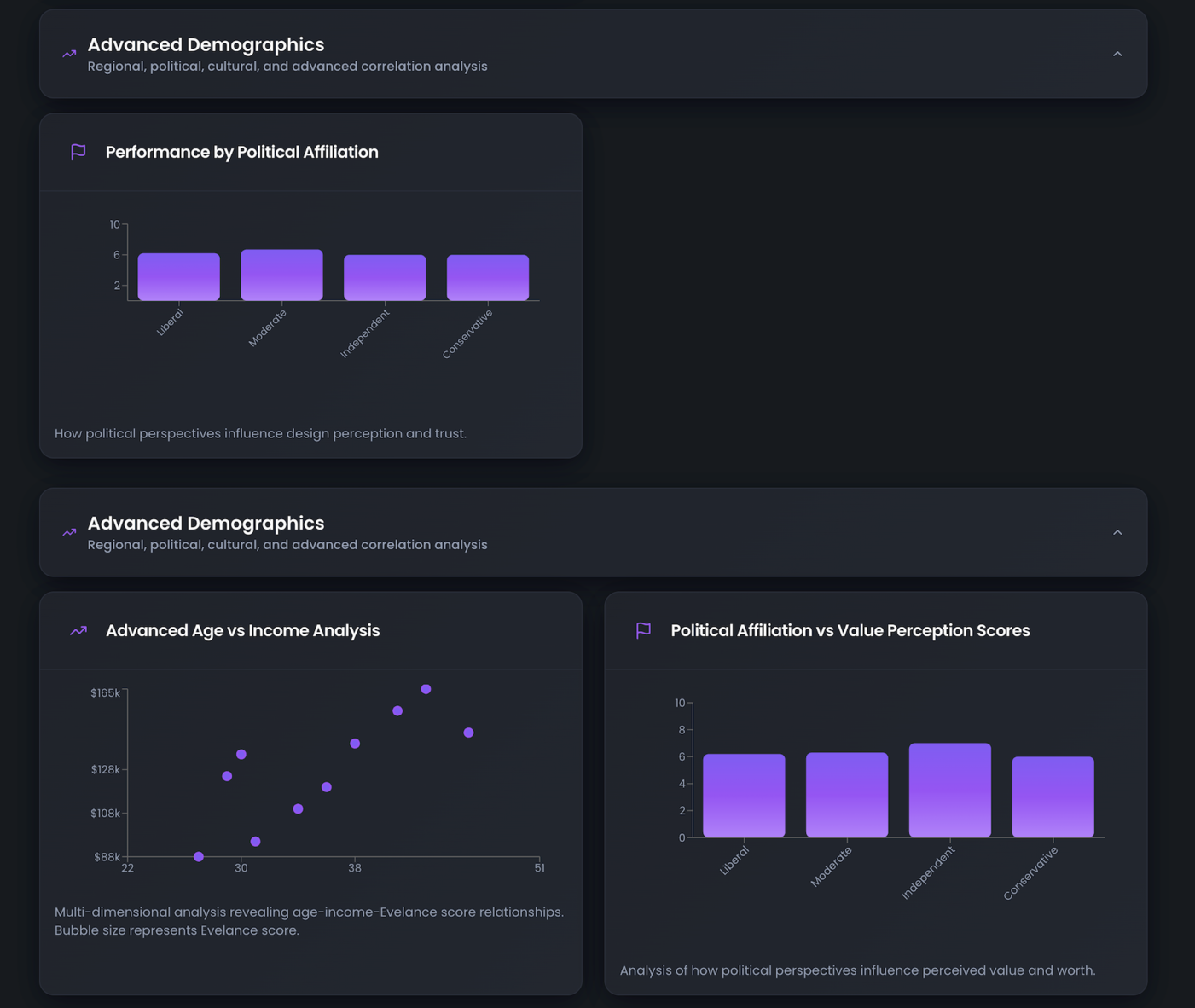
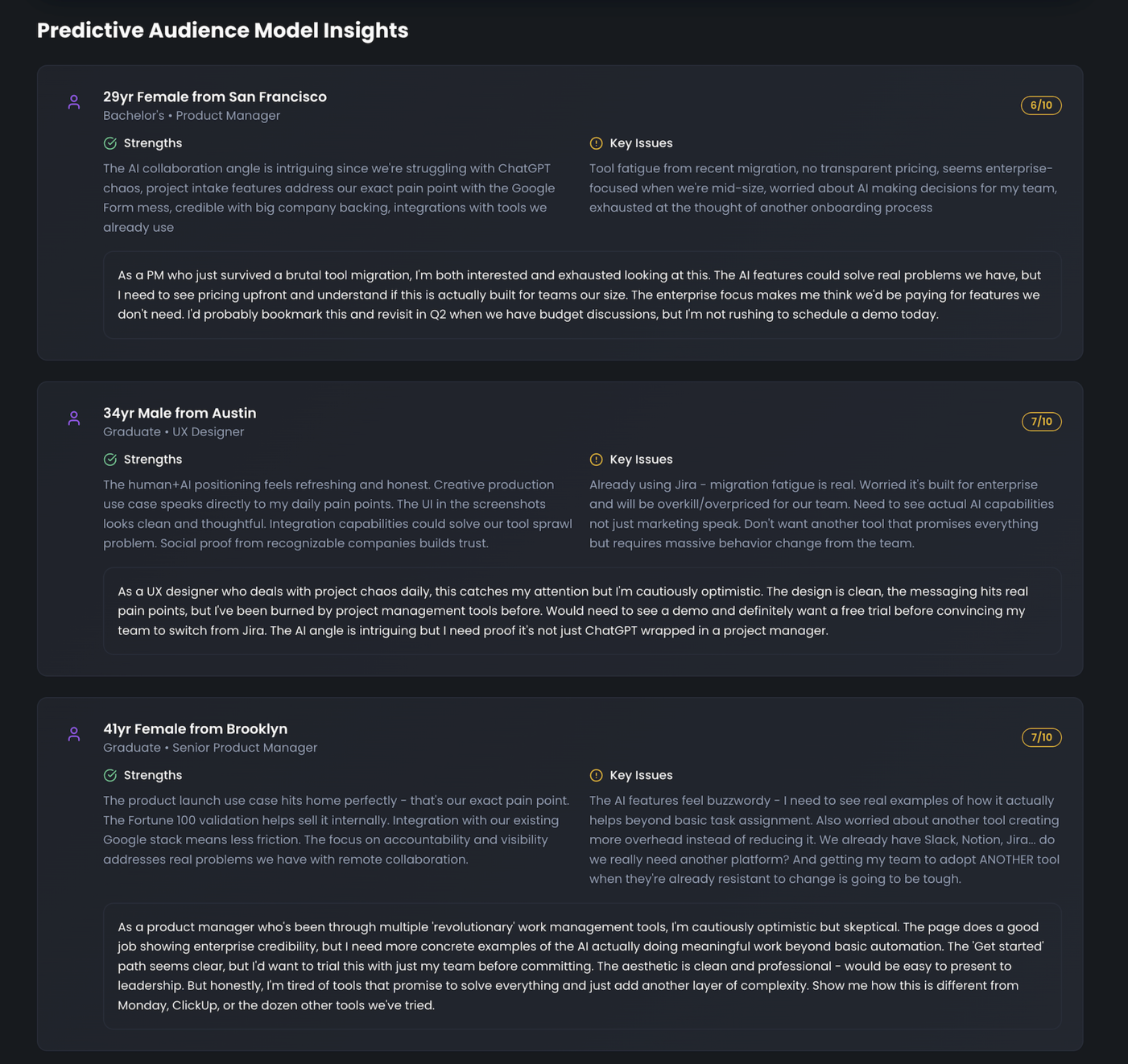
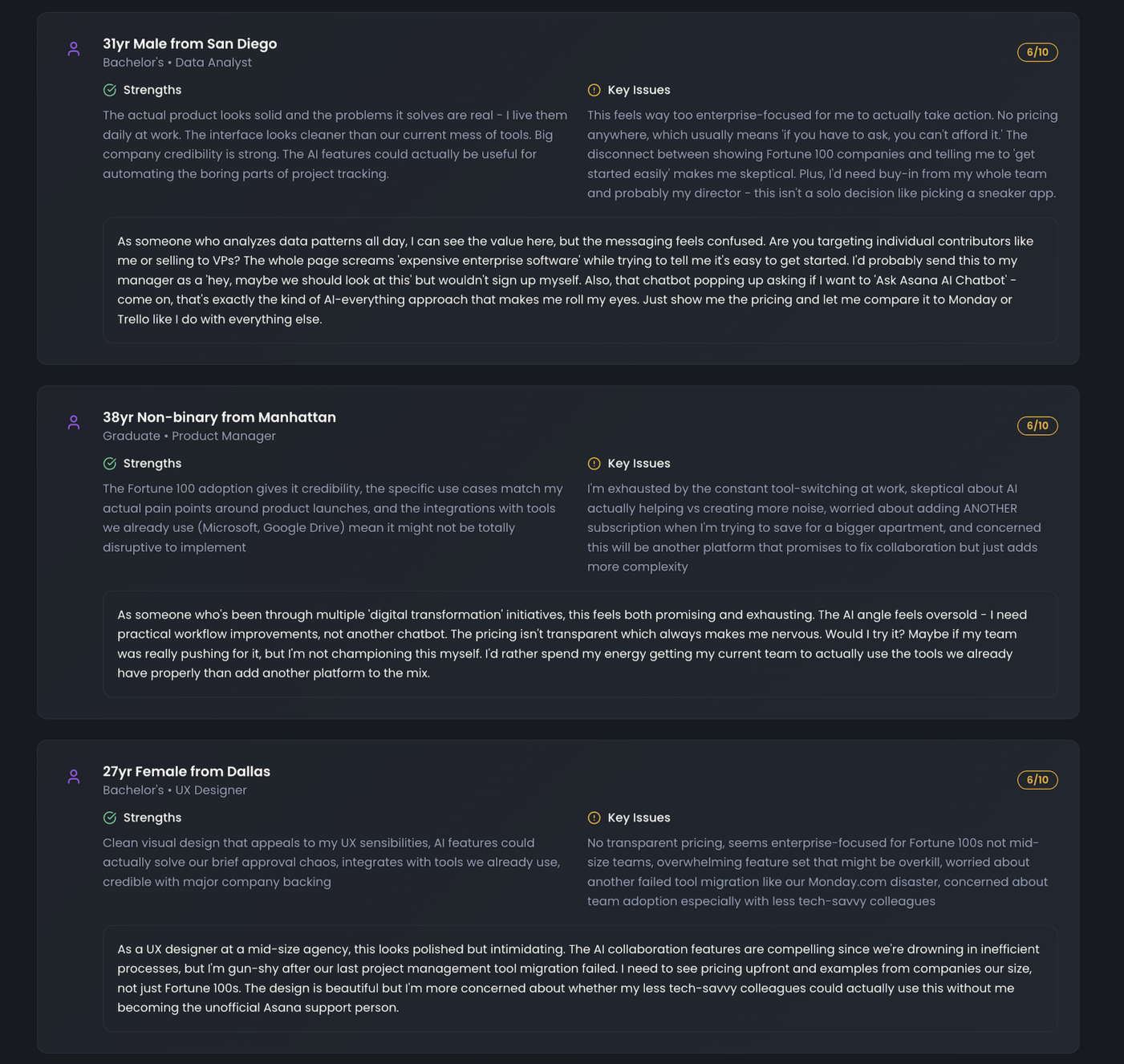
evelanceAI Synthesized PDF
Plain Text Results from Evelance’s Dashboard
Overall Assessment
The psychological patterns reveal a profound tension between genuine interest and deep-seated tool migration trauma across all participants. Every single person carries emotional baggage from failed implementations, creating a psychological barrier where they simultaneously recognize the value proposition while feeling exhausted at the prospect of another change. The Fortune 100 credibility creates a fascinating psychological paradox – it builds trust while triggering anxiety about whether the solution is appropriate for their mid-size teams. The AI positioning evokes mixed emotional responses, with participants expressing both intrigue and skepticism about whether it represents genuine innovation or marketing hype. Most critically, the lack of transparent pricing triggers immediate defensive responses, with participants interpreting this as a signal that the product is beyond their reach. The psychological profile shows people who are cognitively interested but emotionally resistant, creating a state where they bookmark rather than act. The enterprise-focused messaging creates cognitive dissonance for individual contributors and mid-level managers who see their problems reflected but question whether they’re the intended audience.
Priority Recommendations
Address the migration trauma directly by acknowledging it upfront and showing exactly how this differs from previous failed attempts. Create a dedicated section for mid-size companies with relevant case studies and pricing transparency to resolve the psychological tension between enterprise credibility and accessibility concerns. Reframe the AI narrative from revolutionary to practical by showing specific before-and-after scenarios of daily workflows rather than abstract promises. Add a pricing calculator or transparent tier structure to eliminate the psychological barrier of unknown costs that triggers immediate defensive responses. Include testimonials from people who survived tool migrations successfully, speaking to the emotional journey not just the functional outcomes. Create clear messaging differentiation between enterprise buyers and team-level decision makers to resolve the audience confusion. Show concrete examples of partial adoption success where teams started small and expanded, addressing the all-or-nothing fear. Develop content that speaks to the emotional exhaustion of constant tool switching while demonstrating why this particular change is worth the effort.
What Next
Conduct focused psychological research on the specific moment when interested visitors abandon without taking action, mapping the exact emotional triggers that shift them from curiosity to resistance. Study the psychological impact of showing pricing early versus late in the consideration journey for this specific audience segment. Test messaging that directly acknowledges tool fatigue versus avoiding the topic entirely to understand which approach creates stronger emotional permission to engage. Research the psychological difference between positioning as a replacement versus an enhancement to existing tools. Investigate how different proof points impact trust building for mid-size versus enterprise audiences. Explore the emotional journey of successful tool migrations to identify the psychological factors that overcome resistance. Study how team champions versus individual users process information differently and what motivates each group to take action.
Expert Opinion
The core psychological challenge isn’t selling features but overcoming collective trauma from failed digital transformations. Every participant exhibited classic symptoms of change fatigue – recognizing problems while emotionally protecting themselves from another disappointment. The enterprise positioning creates a fascinating psychological barrier where credibility actually reduces accessibility perception. Until the messaging addresses the emotional exhaustion directly and provides transparent, accessible pathways for mid-size teams, visitors will remain in perpetual evaluation mode, bookmarking but never committing.
Plain Text Results from Individual Evelance Predictive Personas
29yr Female from San Francisco | Bachelor’s | Product Manager
- Score: 6/10
- Strengths: The AI collaboration angle is intriguing since we’re struggling with ChatGPT chaos, project intake features address our exact pain point with the Google Form mess, credible with big company backing, integrations with tools we already use.
- Key Issues: Tool fatigue from recent migration, no transparent pricing, seems enterprise-focused when we’re mid-size, worried about AI making decisions for my team, exhausted at the thought of another onboarding process.
- As a PM who just survived a brutal tool migration, I’m both interested and exhausted looking at this. The AI features could solve real problems we have, but I need to see pricing upfront and understand if this is actually built for teams our size. The enterprise focus makes me think we’d be paying for features we don’t need. I’d probably bookmark this and revisit in Q2 when we have budget discussions, but I’m not rushing to schedule a demo today.
34yr Male from Austin | Graduate | UX Designer
- Score: 7/10
- Strengths: The human+AI positioning feels refreshing and honest. Creative production use case speaks directly to my daily pain points. The UI in the screenshots looks clean and thoughtful. Integration capabilities could solve our tool sprawl problem. Social proof from recognizable companies builds trust.
- Key Issues: Already using Jira – migration fatigue is real. Worried it’s built for enterprise and will be overkill/overpriced for our team. Need to see actual AI capabilities not just marketing speak. Don’t want another tool that promises everything but requires massive behavior change from the team.
- As a UX designer who deals with project chaos daily, this catches my attention but I’m cautiously optimistic. The design is clean, the messaging hits real pain points, but I’ve been burned by project management tools before. Would need to see a demo and definitely want a free trial before convincing my team to switch from Jira. The AI angle is intriguing but I need proof it’s not just ChatGPT wrapped in a project manager.
41yr Female from Brooklyn | Graduate | Senior Product Manager
- Score: 7/10
- Strengths: The product launch use case hits home perfectly – that’s our exact pain point. The Fortune 100 validation helps sell it internally. Integration with our existing Google stack means less friction. The focus on accountability and visibility addresses real problems we have with remote collaboration.
- Key Issues: The AI features feel buzzwordy – I need to see real examples of how it actually helps beyond basic task assignment. Also worried about another tool creating more overhead instead of reducing it. We already have Slack, Notion, Jira… do we really need another platform? And getting my team to adopt ANOTHER tool when they’re already resistant to change is going to be tough.
- As a product manager who’s been through multiple ‘revolutionary’ work management tools, I’m cautiously optimistic but skeptical. The page does a good job showing enterprise credibility, but I need more concrete examples of the AI actually doing meaningful work beyond basic automation. The ‘Get started’ path seems clear, but I’d want to trial this with just my team before committing. The aesthetic is clean and professional – would be easy to present to leadership. But honestly, I’m tired of tools that promise to solve everything and just add another layer of complexity. Show me how this is different from Monday, ClickUp, or the dozen other tools we’ve tried.
31yr Male from San Diego | Bachelor’s | Data Analyst
- Score: 6/10
- Strengths: The actual product looks solid and the problems it solves are real – I live them daily at work. The interface looks cleaner than our current mess of tools. Big company credibility is strong. The AI features could actually be useful for automating the boring parts of project tracking.
- Key Issues: This feels way too enterprise-focused for me to actually take action. No pricing anywhere, which usually means ‘if you have to ask, you can’t afford it.’ The disconnect between showing Fortune 100 companies and telling me to ‘get started easily’ makes me skeptical. Plus, I’d need buy-in from my whole team and probably my director – this isn’t a solo decision like picking a sneaker app.
- As someone who analyzes data patterns all day, I can see the value here, but the messaging feels confused. Are you targeting individual contributors like me or selling to VPs? The whole page screams ‘expensive enterprise software’ while trying to tell me it’s easy to get started. I’d probably send this to my manager as a ‘hey, maybe we should look at this’ but wouldn’t sign up myself. Also, that chatbot popping up asking if I want to ‘Ask Asana AI Chatbot’ – come on, that’s exactly the kind of AI-everything approach that makes me roll my eyes. Just show me the pricing and let me compare it to Monday or Trello like I do with everything else.
38yr Non-binary from Manhattan | Graduate | Product Manager
- Score: 6/10
- Strengths: The Fortune 100 adoption gives it credibility, the specific use cases match my actual pain points around product launches, and the integrations with tools we already use (Microsoft, Google Drive) mean it might not be totally disruptive to implement.
- Key Issues: I’m exhausted by the constant tool-switching at work, skeptical about AI actually helping vs creating more noise, worried about adding ANOTHER subscription when I’m trying to save for a bigger apartment, and concerned this will be another platform that promises to fix collaboration but just adds more complexity.
- As someone who’s been through multiple ‘digital transformation’ initiatives, this feels both promising and exhausting. The AI angle feels oversold – I need practical workflow improvements, not another chatbot. The pricing isn’t transparent which always makes me nervous. Would I try it? Maybe if my team was really pushing for it, but I’m not championing this myself. I’d rather spend my energy getting my current team to actually use the tools we already have properly than add another platform to the mix.
27yr Female from Dallas | Bachelor’s | UX Designer
- Score: 6/10
- Strengths: Clean visual design that appeals to my UX sensibilities, AI features could actually solve our brief approval chaos, integrates with tools we already use, credible with major company backing.
- Key Issues: No transparent pricing, seems enterprise-focused for Fortune 100s not mid-size teams, overwhelming feature set that might be overkill, worried about another failed tool migration like our Monday.com disaster, concerned about team adoption especially with less tech-savvy colleagues.
- As a UX designer at a mid-size agency, this looks polished but intimidating. The AI collaboration features are compelling since we’re drowning in inefficient processes, but I’m gun-shy after our last project management tool migration failed. I need to see pricing upfront and examples from companies our size, not just Fortune 100s. The design is beautiful but I’m more concerned about whether my less tech-savvy colleagues could actually use this without me becoming the unofficial Asana support person.
43yr Male from Los Angeles | Graduate | Director of Product
- Score: 6/10
- Strengths: The approval workflow and project tracking directly address my daily pain points. Strong company validation helps with buy-in. Integrations with our existing tools means less friction with IT.
- Key Issues: Another tool migration sounds exhausting after what we just went through. The AI component makes me nervous about accountability and my team’s resistance. I’m worried about becoming the guy who keeps pushing new tools on an already overwhelmed team.
- This looks solid but I’m tired of tool promises. The AI angle is both intriguing and concerning – I need to know it won’t create more confusion about ownership. Would need to see a demo focused on our specific product launch chaos before I’d stick my neck out to champion this internally. Maybe I’ll bookmark it and revisit after our Q1 launch when I have more bandwidth to think about process improvements.
36yr Male from Houston | Bachelor’s | Product Analyst
- Score: 6/10
- Strengths: Microsoft integration is crucial, Fortune 100 credibility helps, addresses our exact pain points with product launches and project tracking, Gartner/Forrester recognition means it’s probably not vaporware.
- Key Issues: Too many tools already, team adoption concerns, cost for 40+ users unclear, privacy/security questions unanswered, worried about another failed tool migration like we had with Jira last year.
- This looks powerful but I’m exhausted just thinking about getting buy-in from leadership AND convincing my team to learn another system. The AI stuff feels oversold – I just need basic project tracking that actually works. Would need to see a real demo with our actual workflow, not these generic marketing screenshots. And somebody needs to tell me exactly how much this costs for 40 users before I waste time in a sales call. The privacy chatbot actually makes me more nervous about data security, not less.
30yr Female from San Jose | Graduate | Senior UX Designer
- Score: 6/10
- Strengths: The use cases are spot-on for my daily work struggles. Strong credibility with Fortune 100 companies and analyst recognition. The interface looks cleaner than what we currently use. The focus on shareability and templates addresses real pain points.
- Key Issues: The AI integration feels both promising and risky – I don’t trust AI to understand our team dynamics. Plus, the trauma of our recent tool migration makes me resistant to another switch, even if this might be better. The enterprise focus makes me wonder if it’s too complex for our mid-size company needs.
- As a UX designer who’s been burned by project management tool migrations, I’m simultaneously intrigued and skeptical. The AI angle is interesting but needs more concrete examples of how it actually works without creating more problems. The page feels very enterprise-focused when I need to know it won’t be overkill for my team. Show me how this is different from Monday, Notion, or ClickUp – not just that big companies use it.
46yr Male from Albany | Bachelor’s | Senior Product Manager
- Score: 7/10
- Strengths: Strong enterprise credibility with Fortune 100 adoption, appears to integrate with our existing Microsoft and Salesforce stack, addresses real pain points around project visibility and accountability we’re experiencing.
- Key Issues: No transparent pricing, skeptical about AI features actually being useful vs. hype, concerned about team adoption resistance, and worried about another lengthy implementation process right before year-end planning.
- As a senior PM who’s implemented (and suffered through) multiple project management tools, this looks promising but I need concrete demos and pricing before I’d champion this internally. The AI angle feels oversold – I’d rather see real workflow examples from companies our size. Would definitely bookmark this to investigate further, maybe schedule a demo after Q4, but not rushing to click ‘Get started’ without understanding the actual commitment involved.


 Oct 05,2025
Oct 05,2025